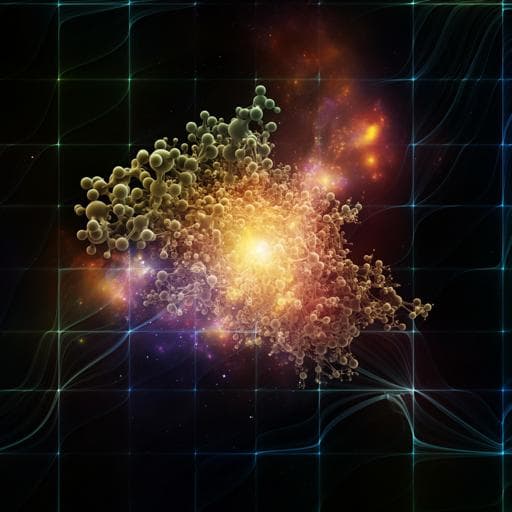
Physics
Real-space subfemtosecond imaging of quantum electronic coherences in molecules
M. Garg, A. Martin-jimenez, et al.
This groundbreaking research by M. Garg, A. Martin-Jimenez, M. Pisarra, Y. Luo, F. Martín, and K. Kern reveals the potential of real-time imaging of quantum electronic coherences in molecules. Using advanced scanning tunneling microscopy and attosecond laser pulses, they visualize electron dynamics with unprecedented precision, opening new avenues for manipulating molecular systems.
~3 min • Beginner • English
Introduction
Chemical transformations are governed by valence electron motion and its coupling to nuclear dynamics. While attosecond techniques can create and monitor coherent superpositions of valence electronic states on their natural timescales, they do not yield spatially localized information, so local electron-density evolution is typically inferred from spectra. Light–matter interactions at molecular scales offer ångström spatial and sub-femtosecond temporal access, and lightwave-driven STM has enabled generation and control of ultrafast tunnelling currents. However, simultaneous real-space and real-time visualization of electron dynamics remained elusive. The authors combine CEP-stable, few-cycle (<6 fs) near-infrared pulses with an STM to directly follow coherences between molecular orbitals of PTCDA on Au(111) with ångström spatial and sub-femtosecond temporal resolution, exceeding previous space-time limits and avoiding reconstruction.
Literature Review
Prior work in attosecond science demonstrated generation and tracking of valence electronic coherences through spectroscopic observables (electron, ion, absorption, emission), but without direct spatial imaging (e.g., attosecond HHG-based methods, ultrafast photoionization, time-resolved orbital tomography). STM provides local probing of LDOS and molecular orbitals, and ultrafast/terahertz-driven STM has tracked ultrafast motion and controlled tunnelling on sub-cycle to few-hundred-attosecond timescales. Nonetheless, direct, concurrent real-space and real-time imaging of electronic coherences had not been achieved. The present study bridges these advances by integrating CEP-stable few-cycle NIR pulses with STM detection to image and control coherent population dynamics between specific molecular and surface states, validated against two-level models and DFT-based simulations.
Methodology
Experimental platform: A tungsten nanotip in tunnelling contact with PTCDA layers on Au(111) was illuminated by two orthogonally polarized, CEP-stable near-infrared pulses (<6 fs, central wavelength ≈810 nm) with slightly offset carrier frequencies generated via an acousto-optic frequency shifter. Polarization axes formed 45° with the tip axis, enabling overlap of field components along both the tip axis (normal to surface) and molecular plane, producing homodyne beating between polarization components. Laser intensity was ~1×10^12 W cm^−2 (Keldysh parameter γ>1), ensuring photon-driven rather than field-driven tunnelling. Cross-correlation of laser-induced tunnelling current versus pulse delay characterized the temporal overlap. The laser-induced current was recorded as a function of bias, tip–sample distance (I–Δz), polarization, and pulse delay using STM in constant-current mode.
Electronic level alignment and bias control: Scanning tunnelling spectroscopy established resonances at −1.8 V (HOMO), +1.4 V (LUMO) for PTCDA on Au(111), and −0.3 V for the Coulomb-shifted Au(111) surface state. By tuning the d.c. bias, the initial state for laser-assisted transitions was selected: HOMO→surface state or surface state/EF→LUMO via single-photon (≈1.5 eV) coupling. Single-pulse condition (zero delay) in this geometry left only the tip-axis field active at the junction; non-zero delay reintroduced in-plane components allowing coherent control.
Single-pulse imaging: With a single effective pulse, population transfer is initiated but Rabi oscillations are negligible because the Rabi period (2πħ/(μE0)) exceeds pulse duration given small μ along the tip axis and the used E-field. Ultrafast tunnelling times (<0.5 fs) prevent post-pulse exchange, so tunnelling current maps the lower state’s spatial LDOS. Spatial maps were acquired at biases aligning HOMO, surface state, or LUMO, revealing orbital-resolved contrast and symmetry across small bias ranges where identical initial/final states are accessed.
Two-pulse coherent control and imaging: Coherent dynamics were induced by varying the delay τ between pulses 1 and 2 while imaging the laser-induced current. A two-level analytical model with decoherence was used to describe populations ρ_l and ρ_u as functions of τ, incorporating transition dipole components parallel (μ_||) and perpendicular (μ_⊥) to the molecular plane and level broadening Γ (≈0.4 eV for monolayer on Au(111)). Optimal coherent interference required temporal overlap due to very fast decoherence (few-fs). Space–time maps were recorded, and integrating current over regions provided population dynamics.
Multilayer decoupling and orbital imaging: To isolate purely molecular coherences, four-monolayer PTCDA films were grown to decouple upper layers from the Au(111) surface via weak van der Waals interactions. STS confirmed disappearance of the surface state and a HOMO–LUMO gap ~2.5–3.0 eV. Excitation pathways included single-photon transitions from the blue tail or sequential two-photon processes at the pulse peak frequency. Spatial maps at HOMO (−1.8 V) and LUMO (+1.4 V) biases showed row-dependent contrast due to vertical stacking-induced lateral displacements (~1 Å) affecting LDOS.
Theory and simulation: A two-state model captured coherent population oscillations using parameters fitted to experiment: for monolayer HOMO–surface-state, E≈0.25 V Å^−1, decoherence time ~5 fs, μ_||≈1 a.u., μ_⊥≈0.2 a.u.; for four-layer HOMO–LUMO, E≈0.25 V Å^−1, decoherence ~10 fs, μ_||≈0.8 a.u., μ_⊥≈0.1 a.u. DFT calculations (including Tersoff–Hamann approximation) simulated STM images of HOMO/LUMO; convolution with an s-type tip wavefunction (decay lengths 1.8 Å vertical, 0.8 Å lateral) reproduced measured spatial profiles, confirming ångström-scale resolution far below the diffraction limit. I–Δz measurements established exponential dependence matching d.c. tunnelling, and I–V with lasers identified resonances at HOMO, LUMO, and Au(111) surface state.
Key Findings
- Direct, concurrent real-space (ångström-scale) and real-time (sub-femtosecond) imaging of quantum electronic coherences in PTCDA molecules on Au(111) using CEP-stable <6 fs NIR pulses integrated with STM.
- Laser-induced tunnelling current spectra display resonant features at −1.8 V (HOMO), +1.4 V (LUMO), and −0.3 V (Au(111) surface state). The laser-driven current scales exponentially with gap width similarly to d.c. tunnelling, confirming a tunnelling origin and sensitivity to LDOS and transition dipole matrix elements.
- Single-pulse imaging maps the spatial profile of the lower electronic state involved: HOMO images when HOMO is aligned with EF; strong surface-state contrast when surface state is aligned; and LUMO-like patterns at 1.4 V due to elastic pre-pulse tunnelling and subsequent photon coupling.
- Coherent beating between HOMO and Au(111) surface state in monolayer PTCDA observed with an oscillation period ~2.7 fs. Population dynamics extracted from space–time maps agree with a two-level model using E≈0.25 V Å^−1, μ_||≈1 a.u., μ_⊥≈0.2 a.u., and electronic decoherence time ~5 fs.
- In four-monolayer PTCDA (surface state absent; HOMO–LUMO gap ~2.5–3.0 eV), real-space–time imaging shows counter-phase HOMO–LUMO oscillations with period ~1.4 fs, consistent with the larger energy gap. Two-level modeling with μ_||≈0.8 a.u., μ_⊥≈0.1 a.u., and decoherence ~10 fs reproduces the dynamics.
- Ångström-scale spatial resolution achieved with near-infrared excitation, far below the optical diffraction limit, validated by agreement between measured maps and DFT/Tersoff–Hamann simulations convolved with a realistic tip wavefunction.
- Control over orbital population by adjusting pulse delay enables switching between imaging HOMO-like and surface/LUMO-like densities, demonstrating coherent manipulation at sub-femtosecond timescales.
Discussion
The study addresses the long-standing challenge of directly visualizing ultrafast electron dynamics in both space and time. By coupling CEP-stable few-cycle laser fields into an STM junction, the authors induce and read out coherent population transfer between specific electronic states at atomic length scales. The delay-dependent space–time maps reveal quantum beating between well-defined levels (HOMO–surface state in the monolayer and HOMO–LUMO in the multilayer), demonstrating that electron densities can be localized and switched on sub-fs timescales with ångström resolution. Agreement with a decoherence-inclusive two-level model and DFT-supported spatial profiles confirms that the laser-induced tunnelling current encodes the instantaneous electronic population distribution. This capability provides a direct, non-reconstructive route to study and manipulate electron motion relevant to chemical reactivity, intermolecular coupling, and device-relevant interfaces, thereby extending attosecond science into the regime of local, orbital-resolved dynamics.
Conclusion
By integrating CEP-stable <6 fs near-infrared pulses with STM, the work demonstrates real-space sub-ångström and real-time sub-femtosecond imaging and control of electronic coherences in molecules. The authors image HOMO, LUMO, and surface-state densities, observe coherent oscillations with characteristic periods (~2.7 fs in monolayer HOMO–surface-state and ~1.4 fs in multilayer HOMO–LUMO systems), and quantitatively reproduce the dynamics with a two-level model including decoherence. The approach overcomes previous limitations that required indirect reconstruction, opening avenues for direct observation and control of electron dynamics in complex molecules, two-dimensional materials, and correlated systems. Future research could extend to site- and state-selective coherent control of charge transfer in photosynthetic and light-harvesting complexes, map electron–phonon coupling at the single-molecule level, explore many-level coherence in larger molecular assemblies, and integrate waveform shaping for tailored population transfer.
Limitations
- Coherent interference required temporal overlap of pulses due to very fast electronic decoherence (few-femtosecond), limiting usable delay windows and signal visibility at longer delays.
- The simple two-level description captures main features but deviations (e.g., non-monotonic oscillation amplitudes in multilayers) indicate contributions from multi-level dynamics and competing one- vs two-photon pathways.
- Transition dipole components along the tip axis are small in planar geometries, restricting Rabi cycling under the available fields; population transfer is thus limited by pulse duration and coupling strength.
- The method relies on specific bias alignment of levels and junction conditions; results can be sensitive to tip structure, local stacking, and layer-dependent LDOS variations.
- Broad linewidths (Γ≈0.4 eV in monolayers) shorten coherence times, constraining the maximum temporal window for tracking dynamics.
Related Publications
Explore these studies to deepen your understanding of the subject.







